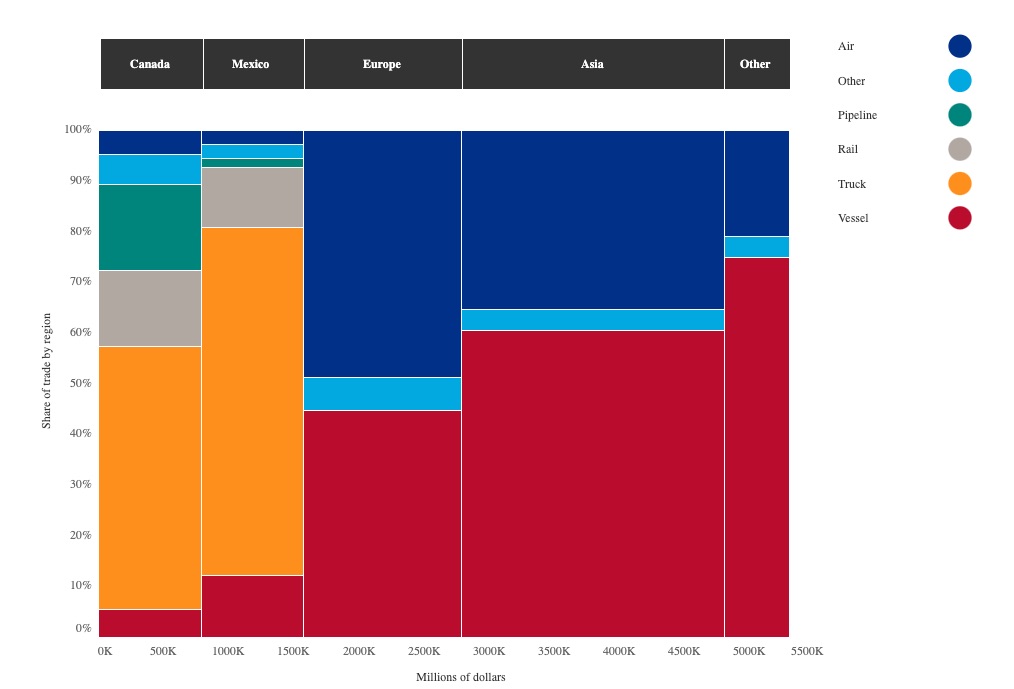Last Updated on December 5, 2024

Introduction: The Power of Nearshoring in North America
The North American trade corridor is redefining global supply chains by fostering nearshoring opportunities that streamline operations, reduce costs, and accelerate market access. As businesses seek resilience and agility, nearshoring in Mexico and across North America has become a cornerstone of modern manufacturing and trade strategies.

The North American Trade Corridor: A Critical Economic Driver
What is the North American Trade Corridor?
The North American Trade Corridor is an integrated system of transportation and logistics networks that links major trade hubs across the continent. It enables efficient cross-border commerce by reducing transit times, optimizing supply chains, and enhancing connectivity between industrial and consumer markets.
The trade corridor—encompassing key routes like the USMCA (United States-Mexico-Canada Agreement) region—has emerged as a pivotal infrastructure connecting businesses to global markets. With over $1.5 trillion in annual trade, this corridor plays a vital role in integrating supply chains, facilitating cross-border collaboration, and ensuring logistical efficiency.
Key Components of the North American Trade Corridor
- The I-35 corridor, known as the "NAFTA Highway," runs from Laredo, Texas, to Winnipeg, Canada, passing through key industrial cities.
- Mexico’s Federal Highway 85 complements this by connecting major cities to border crossings.
- Railways like Kansas City Southern and Ferromex connect manufacturing hubs in Mexico with U.S. distribution centers.
- These networks reduce freight costs and enable bulk transportation.
- Strategic crossings such as Laredo, El Paso, and Nogales handle millions of truckloads annually.
- Ports like Houston and Veracruz facilitate intermodal transportation, linking ocean shipping with inland freight.
- Industrial parks and warehouses along the corridor enhance supply chain efficiency.
- Key cities like Monterrey, Dallas, and Toronto serve as critical nodes.
Benefits of the North American Trade Corridor for Nearshoring
- Reduced Lead Times: Proximity enables faster production and delivery cycles.
- Cost-Efficient Logistics: Lower transportation costs than transoceanic shipping.
- Risk Mitigation: Minimize geopolitical disruptions and natural disaster risks.
Regional and Mode-Specific Freight Flows Between the U.S. And International Markets

Benefits of Nearshoring Supply Chains in North America
Proximity to Major Markets
Nearshoring allows companies to be closer to North America's largest consumer markets, including the United States and Canada. This proximity reduces delivery times and ensures faster demand response.
Streamline Logistics and Transportation
Efficient Cross-Border Trade: Well-established trade routes, like the North American trade corridor, facilitate seamless cross-border operations.
Lower Transportation Costs: Compared to shipping from Asia, nearshoring dramatically reduces freight expenses.
A skilled workforce and advanced manufacturing
North America offers access to a diverse, skilled labor pool.
Mexico: Specializes in the automotive, electronics, textiles, and aerospace industries.
Canada: Advanced manufacturing and natural resource processing.
United States: R&D, high-tech manufacturing, and distribution hubs.
Favorable trade policies
The United States-Mexico-Canada Agreement (USMCA) simplifies trade across the region, providing tariff advantages and reducing regulatory barriers.
Why Mexico Is the Hub of Nearshoring Growth
Mexico stands at the heart of North America's nearshoring boom. Its manufacturing capacity, skilled workforce, and competitive costs make it the preferred destination for foreign direct investment (FDI).
Advantages of Mexico for Nearshoring
- Strategic Location: Sharing a border with the U.S., Mexico offers unparalleled proximity to North American markets.
- Cost-Competitive Labor: Mexican labor rates are highly competitive with China and Southeast Asia.
- Advanced Manufacturing: Mexico boasts thriving industries in automotive, aerospace, textiles, and electronics.
- Favorable Trade Agreements: Beyond USMCA, Mexico is part of numerous bilateral agreements enhancing market access.
Industrial Parks and clusters
Industrial clusters across Mexico cater to specialized sectors. These parks provide:
- Access to skilled labor.
- Integrated supply chain ecosystems.
- Proximity to key logistics hubs.
Potential Challenges
While nearshoring offers numerous advantages, businesses must navigate challenges such as:
- Infrastructure Bottlenecks: Upgrading roads, ports, and rail networks remains critical.
- Regulatory Compliance: Understanding and adhering to Mexican labor and environmental laws.
- Cultural and Operational Alignment: Bridging cultural differences to ensure smooth collaboration.
Strategic Solutions
- Infrastructure Investment: Government and private sector initiatives drive modernization projects.
- Strong Partnerships: Partnering with experienced nearshore service providers mitigates risks.
- Comprehensive Due Diligence: Leveraging market research and local expertise to ensure compliance.
Case Studies: Successful Nearshoring in the North American Trade Corridor
Automotive Manufacturing in Mexico
Leading automakers such as Ford, BMW and Volkswagen have established production facilities in states like Guanajuato and Puebla, leveraging skilled labor and advanced manufacturing technologies. Proximity to U.S. markets ensures efficient delivery and cost savings.
Electronics Assembly in Mexico
Mexico has become a hub for electronics manufacturing, producing components for global technology leaders. The country's proximity to California and its established indusshed industrial base make it a key player in the electronics supply chain.
Top Commodity Transported Between the U.S. And Mexico for Each Mode of Transportation

Conclusion: Seizing the Nearshoring Opportunity
The North American trade corridor is the backbone of nearshoring success, enabling businesses to achieve operational excellence while staying competitive in a rapidly evolving global economy. Companies that invest in nearshoring through Mexico gain unparalleled access to markets, reduced costs, and long-term growth.
North American trade corridors are more than just transportation routes; they are symbols of economic integration between North American countries. In order to maintain North America's economic strength and resilience, it is essential that this corridor grows and is optimized. By investing in infrastructure, technology, and sustainability along the North American trade corridor, we enable future growth as well.
About NovaLink
As a manufacturer in Mexico, NovaLink employs a unique approach that transcends the traditional model of shelter production. More than just the location of your manufacturing, we would like to become a partner in your manufacturing in Mexico. You will be able to relocate or initiate manufacturing for your company in Mexico in a low-cost labor environment with very little delay or up-front costs. Find out how we can help you by handling the manufacturing process.
There are NovaLink facilities in the border cities of Brownsville, Texas, Matamoros, Mexico, and Saltillo, Mexico.